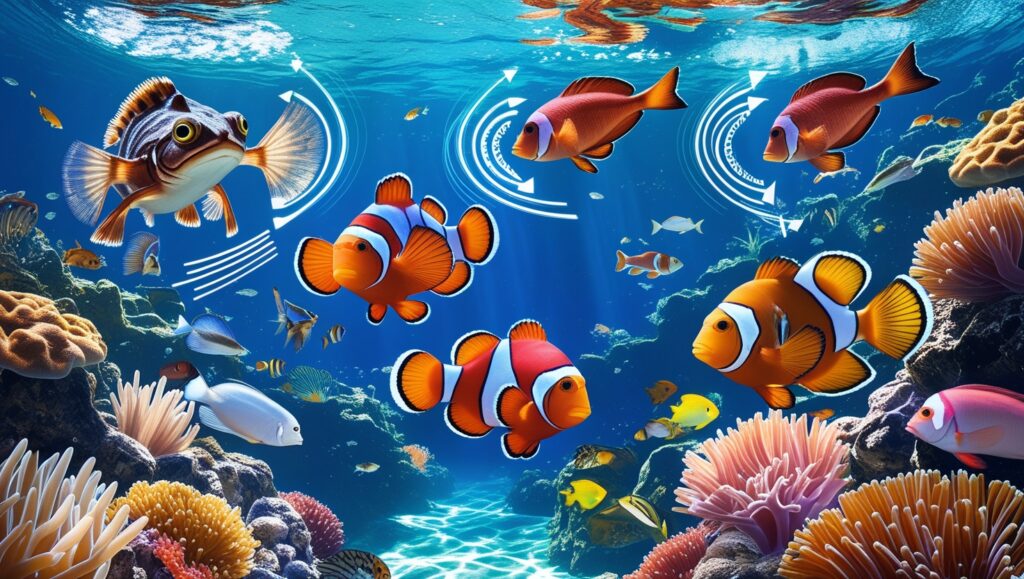When you think of communication, you might imagine people talking, texting, or even animals barking or chirping. But did you know that fish have their own fascinating ways of “talking” to each other underwater? That’s right! In the deep blue sea, where sound travels faster than it does in air, fish use a variety of methods to send messages to one another. Let’s dive into the underwater world and uncover the secrets of fish communication.
Sound: The Language of the Deep
One of the most common ways fish communicate is through sound. But how does a fish, without vocal cords, make noise? The answer lies in their bodies! Many fish use specialized parts, like their swim bladders (a gas-filled organ that helps them stay buoyant), to produce sounds. By contracting muscles around their swim bladder, they create vibrations that travel through the water. These sounds can be anything from clicks and grunts to whistles and booms.
For example, the toadfish is known for its loud, croaking calls that resemble the sound of a toad—hence its name. Male toadfish make these calls to attract females or warn rivals to stay away. Similarly, the damselfish produces popping sounds to defend its territory or scare off predators.
Fun Fact #1: The Gulf corvina, a fish found in the Gulf of California, is so noisy during mating season that their collective sounds can reach over 190 decibels. That’s louder than a rock concert!
Body Language: Silent but Clear

Not all fish rely on sound. Many species use body language to communicate. This can include fin movements, body postures, or even changing colors. For instance, the clownfish (yes, like Nemo!) performs a sort of “dance” with its fins and body to signal to its anemone partners or warn other fish to back off.
Another great example is the cutthroat trout, which changes its body posture to show dominance or submission. By raising its fins or lowering its head, it can signal whether it’s ready to fight or prefers to avoid conflict.
Fun Fact #2: Some fish, like the parrotfish, secrete a mucus cocoon at night. While this may seem gross, it’s actually a way of signaling to predators, “I’m not worth the effort!”
Color Changes: Speaking Through Shades
Have you ever seen a fish suddenly change its color? This isn’t just for show; it’s a powerful communication tool. Many fish, like the cuttlefish and mandarinfish, use their colors to send messages. For instance, a male mandarinfish might display vibrant colors to attract a mate, while a predator might change to blend in with its surroundings and signal, “I’m invisible, don’t bother me.”
In addition to mating and camouflage, color changes can also indicate mood. A stressed fish might become pale, while an aggressive one might darken to appear more intimidating.
Fun Fact #3: The cuttlefish is often called the “chameleon of the sea” because it can change both its color and texture within seconds. It’s like having a built-in mood ring and camouflage suit!
Electrical Signals: Nature’s Secret Code

Some fish have taken communication to a whole new level by using electricity. Yes, you read that right—electricity! Fish like the electric eel and electric catfish generate electrical fields to send messages. These signals can help them find prey, navigate murky waters, or even “talk” to other fish of their kind.
For instance, the electric eel emits low-voltage pulses to communicate with potential mates or rivals. Each pulse pattern is unique, almost like a fingerprint, making it easy to recognize who’s who in the water.
Fun Fact #4: The elephantnose fish has a brain so large that it uses a significant portion of its energy to process electric signals. It’s one of the smartest fish in the ocean!
Chemical Signals: Smell the Message
If sound, body language, and electricity aren’t enough, fish also use chemicals to communicate. This is called chemosensory communication. By releasing special chemicals called pheromones into the water, fish can send a variety of messages. These might include warnings about predators, invitations to mate, or even signals to stay together as a group.
For example, when a fish is injured, it releases an “alarm” pheromone that warns nearby fish of danger. This helps the group stay alert and avoid becoming the next meal.
Fun Fact #5: Salmon use their incredible sense of smell to find their way back to the exact stream where they were born. It’s like having a built-in GPS system that uses scent!
Why Does Fish Communication Matter?

Understanding how fish communicate isn’t just fascinating; it’s also important for science and conservation. By studying these underwater conversations, researchers can learn more about fish behavior, ecosystems, and even how to protect endangered species.
For example, knowing that certain fish rely on sound to mate has led scientists to create “quiet zones” in noisy oceans to ensure they can reproduce. Similarly, studying chemical signals has helped researchers develop better ways to manage fish populations and prevent overfishing.
Conclusion
Fish may not have voices like humans, but their world is far from silent. Whether it’s through sound, body language, color changes, electrical signals, or chemicals, fish have developed incredibly diverse ways to communicate. The next time you’re near an aquarium or out snorkeling, take a moment to observe the fish. You might just catch them “talking” to each other in ways you never imagined.
The ocean is a noisy, colorful, and electric world full of hidden conversations. Isn’t it amazing how much we can learn from our underwater friends? So, the next time someone says, “fish are boring,” you’ll have plenty of cool facts to prove them wrong!



